For the past couple of years, there have been more than eighty configurations of crossover SUVs on offer. From small affordable fare such as the Hyundai Kona and Nissan Kicks to hyper-popular compact SUVs such as the Honda CR-V and Nissan Rogue and family-friendly three-row models, such as the Honda Pilot and the Hyundai Santa Fe, there’s an endless pool to choose from. Heck, we won’t even dive into luxury options like the BMW X3, Audi Q3, or Volvo XC90 here—we’ll save those for another guide.
Traditional body-on-frame SUVs like the Chevy Tahoe mean big size and sometimes unwieldy driving dynamics, whereas unibody-construction crossovers are far more car-like. Crossover SUVs can’t truly match sedans in terms of handling or fuel economy, but they are roomy, comfy, and far more utilitarian. They can even be made into good off-roaders, as evidenced by the Subaru Crosstrek and Land Rover Discovery, among others.
Because the variety of crossovers on the new-car market is so immense, we’ve come up with this list of the ten best crossover SUVs of 2025. We dug into a good number of models from popular brands in a variety of niches for different budgets and purposes. Manufacturer suggested retail prices (MSRPs) range from the high $20,000s to the high $40,000s. Every option on this list comes with some form of automatic transmission, and all-wheel drive (AWD) is standard or available across the board. Let’s run through the some of the best SUVs you'll want to look at during your next dealership visit.
The Best Crossover SUVs of 2025
- Dodge Durango
- Hyundai Ioniq 5
- Jeep Grand Cherokee 4xe
- Kia Sportage
- Kia Telluride SX
- Mazda CX-30
- Mazda CX-90
- Subaru Forester
- Toyota Grand Highlander
- Toyota RAV4 Hybrid
Dodge Durango
The Dodge Durango is an old machine in these rankings, having gone without a major redesign since 2011. But despite its age, the Durango is still a decent seller. Why? Because the Durango does things that few other crossover SUVs can, and it’s the King Kong of crossover towing capacity. With a V8 under the hood, the Durango can tow up to 8,700 pounds. Fellow homegrown SUVs, such as the Chevrolet Blazer and the Ford Explorer, can’t touch it in this respect, and only pricey Land Rovers even come close among unibody crossovers (although, in fairness, the ultra-hot SRT Durangos are just as costly).
Those V8-equipped Durangos offer a muscle-car personality with the visuals to match. You can really go crazy with performance here. The Durango offers V8s with 360, 475, or even 710 horsepower (for that blistering 12-second quarter mile) from the $97,000 SRT Hellcat. The Durango does all this while also serving the needs of a busy family, with decent room in all three comfy rows and plenty of storage space.
The downsides of the Durango are those you’d expect from an aging muscle machine. It lacks standard driver-assist gear, and fuel economy ranges from mediocre to awful depending on the engine. It looks like a big brute, but the Durango is a crossover, complete with a fully independent suspension.

Hyundai Ioniq 5
The Hyundai Ioniq 5 s easily the most distinctive of the new breed of compact electric SUVs. The retro-futuristic styling recalls Hyundai’s first car, the 1970s-era Pony car, as well as the original Volkswagen Golf, both penned by design maestro Giorgetto Giugiaro. Whatever its inspiration, the razor-edged Ioniq 5 looks like nothing else on the road and has a roomy, premium-grade interior that’s equally eye-catching. It’s far more visually pleasing and user-friendly than the blobby Tesla Model Y, and it's competitive with that vehicle in many ways.
Although it doesn’t qualify for federal tax credits, the Ioniq 5 has several configurations to choose from with up to 318 miles of EPA-estimated range. Each can fast charge from 10% to 80% in less than 25 minutes on a 350-kW DC fast charger. The base rear-wheel-drive (RWD) SE Standard Range model offers 168 hp and 221 miles of rated range, while the higher SE Long Range offers 225 hp and 318 miles. SEL and Limited can be equipped with AWD, 320 hp, and 260-mile ranges. The sporty XRT trim is another option, as is the high-performance 641-hp Ioniq 5 N.
A little smaller than Hyundai’s gas- or hybrid-powered Tucson, the Ioniq 5 offers plenty of cargo room and a big back seat, though it does trail the Model Y and Volkswagen ID.4 on cargo volume (if it’s outright space you’re after, then the Palisade SUV is worth a look). It comes with lots of tech and safety features, including a pair of 12.3-inch screens on the dash running easy-to-use software (or Android Auto or Apple CarPlay). All told, it’s a beautifully designed and practical commuter.
Jeep Grand Cherokee 4xe
Available in an armada of different trims from utilitarian to serious luxury, the Jeep Grand Cherokee continues to offer consumers style, practicality, genuine off-road ability, and the latest technology, and the 4xe version also offers the company's plug-in hybrid (PHEV) system. Compared to old V8-powered models, the 2025 Grand Cherokee delivers more power, more precise off-road control, and far better fuel economy.
All Grand Cherokees look good, but their capability and luxuriousness can vary greatly. The entry-level Laredo features RWD and is fairly basic inside, while access to the 4xe's efficiency, which becomes available at the Limited trim level, will set you back at least $60,000. The best model in the lineup is probably the Trailhawk, which formerly offered the V8 but is now 4xe-only. It's priced at just over $66,000.
Though that off-road variant isn't cheap, it does combine fully electric range for efficient on-road driving with the Jeep brand's signature rugged off-road capability. Additionally, the 4xe gets the Grand Cherokee’s upscale interior finishes, supreme comfort, and rugged good looks. When you've exhausted its 26-mile electric range, the Grand Cherokee 4xe defaults to fuel efficiency of about 23 mpg in combined driving, which isn't bad gas mileage for a 5,400-pound SUV.
Kia Sportage
The Kia Sportage has vaulted to the top of the compact crossover class in recent years. Granted, the 187-hp base engine is a little tepid, especially compared with the previous generation's 240-hp turbo, but that can be addressed by the excellent 227-hp hybrid or the 261-hp plug-in hybrid, both of which combine compelling performance and excellent fuel mileage. Inside, there’s more cargo and passenger space than the Toyota RAV4, including a limousine-like 41.3 inches of rear legroom that rivals the giant Chevy Tahoe.
The Sportage is also stylish. Kia has been gradually reinventing itself from a brand that sold on price and a long warranty to one that sells on desirability and tech features, and the Sportage is distinctive and cool. There are many standard features, too, although the higher trim levels offer a larger infotainment touchscreen (12.3 to the base model's eight inches) and off-road-oriented mechanical upgrades are reserved for the X-Pro. We've tested the X-Pro off-road, and while it's no Wrangler, it performs admirably on rough terrain.
Behind the Sportage's rear seats are 39.6 cubic feet of cargo space, more than you'll find in the Honda CR-V. This expands to 74.1 cubic feet when the rear seats are folded down. Space is a little tighter in the PHEV version, but not by much, and that model can manage up to 34 miles of fully electric range. If it’s outright space you’re after, then the bigger Kia Sorento SUV is also worth a look.
Equally important, the Sportage is affordable, with a base price hovering a little above $27,000, though that climbs into the mid-$40,000s for the top-of-the-line PHEV variant. Even so, the Sportage is a must-drive for compact crossover shoppers. And don’t forget, all new Kias come with an amazingly long warranty.
Kia Telluride SX
When it was first introduced, the Kia Telluride was so popular there were waiting lists and long lines to get one, and the Korean automaker upped the ante by giving it a mid-cycle refresh back in 2023 (the next is scheduled for 2026). Not only does the Telluride look like a cut-price Range Rover, but it can also be configured to offer a modicum of off-road ability to help earn its butch visage. At heart, the Telluride is a practical, user-friendly, and feature-packed three-row family SUV, and there’s no denying its appeal.
Standard features include a 291-hp V6, a pair of dash-mounted 12.3-inch screens running Kia’s very good UVO infotainment software, and a host of active safety features, including adaptive cruise control. Kia offers the 2025 Telluride in both front-wheel-drive (FWD) and all-wheel-drive (AWD) configurations. The V6 isn’t much of a performer, and fuel mileage is only so-so (there’s no hybrid model), but it can tow up to 5,500 pounds when properly equipped. The X-Pro and Prestige X-Pro trims pack extra off-road gear and an extra 0.4 inches of ground clearance to get you a little farther down the trail.
Inside is a huge second row with an outstanding 42.4 inches of legroom, and the third row is reasonably large, too. At 21 cubic feet, standard cargo space is decent; it can be expanded to 46 cubic feet with the third-row seat folded, or 87 with both rear rows laid flat. It’s hard to go wrong with such a package.
Mazda CX-30
It may seem odd to compare the Mazda CX-30 to the BMW X2 and Mercedes-Benz GLA, but its top trims really are that nice. Among small SUVs, the Mazda CX-30 stands out for its blend of cool styling, excellent handling, and amazing refinement. It’s not the cheapest entry, and it does have some foibles (namely the rotary-controlled infotainment system, subcompact hatchback interior dimensions, and small-ish cargo hold), but the CX-30 looks and feels more expensive than it actually is. Plus, it’s just plain fun to drive, even with the standard engine, and it's less expensive than the Mazda CX-5 or CX-50 without sacrificing too much interior space.
Pricing starts at $25,195, a sum that includes standard AWD and a 191-hp engine. So configured, the CX-30 doesn't feel particularly fast, but very capable handling makes it fun to wring out every last drop of that power. Upgrading to the 250-hp CX-30 Turbo will set you back at least $10,000 more, in exchange for which you'll get the horses to match this Mazda’s enthusiastic moves. Pretty much every automotive journalist agrees that the CX-30 turbo is worth is worth a grin-inducing test drive.
All versions come with standard driver-assist features like adaptive cruise control, blind-spot monitoring, and lane-departure warning. More luxurious trim levels are pricey for a small Mazda, though they’re still more affordable than entry-level luxury crossovers like the Lexus UX or Mercedes GLA. On top of that, the CX-30 is much more satisfying to drive.
The back seat is reasonably sized for the segment, though it isn't best-in-class. There's 20.2 cubic feet of cargo space behind the rear seats, and 45.2 with them folded. Those figure are good, not great. But, if you’re having fun, do you mind?
Mazda CX-90
The Mazda CX-90 looks and feels like a cut-price alternative to much more expensive luxury family SUVs, such as the BMW X3, the Mercedes-Benz GLC, or the Audi Q5. We mean this in good way. Its taut, clean lines look much more exciting than the Grand Highlander or any of its mainstream rivals, and the interior can range from plain to plush just like the Jeep Grand Cherokee's. The third row is a little tighter than some others on this list, but the 2025 CX-90 is much more spacious than its CX-9 predecessor.
Like Mazda’s other products, the CX-90 brings athletic moves to the table. Under the hood is a turbocharged 3.3-liter six-cylinder engine with a mild-hybrid system; depending on trim level, output is 280 or 340 hp. AWD is standard. There’s also a plug-in hybrid CX-90 with 323 hp and up to 26 miles of electric range.
This SUV is lots of fun, and higher trims feel quite luxurious thanks to smart interior materials and Nappa leather seating. So equipped, you'd be looking at a base price of at least $57,950, but most CX-90s cost $10,000-20,000 less than that and feature an abundance of standard safety gear. Overall, the Mazda CX-90 is a near-luxury SUV offering Acura-like tech and BMW-like moves for a reasonable price.
Subaru Forester
Every other manufacturer with a vehicle in this class will loudly tout their affordable base price, which tends to omit the most desirable features. One example is AWD, a feature Subaru includes as standard equipment on nearly every vehicle it sells (the sporty BRZ being the exception), and it even offers a lifted, more-capable Wilderness version for more hard-core off-roading. While most Forester trims entered a new generation for the 2025 model year, the latest and greatest Forester Wilderness won't arrive until the 2026 model year. For shoppers who want to go anywhere, however, Subaru is still selling the previous-generation Wilderness alongside the newer Forester trims.
With AWD factored in, the Forester is between $1,200 and $1,500 less expensive than most comparably equipped rivals, but that’s not the whole story.
The Forester’s cargo area is massive. With all the seats in place, you can fit up to 29.6 cubic feet of gear in the cargo area, or up to 74.4 with the second row folded flat. According to Subaru, that's enough to fit about 23 carry-on suitcases. More importantly, those specs are competitive with the Honda CR-V and the Volkswagen Tiguan, with the Subaru taking the edge thanks to flat-fold seats that make for easier loading.
Although it's pretty dull to drive on the road, the Forester is a decent performer, and it really shines off the pavement. Standard Foresters offer 8.7 inches of ground clearance (much more than a Ford Escape). The Forester Wilderness bumps that up to 9.2 inches and adds skid plates to compete with small off-roaders like the Ford Bronco Sport and Jeep Compass Trailhawk, two models that can't match this Subaru's space, value, and efficiency. Speaking of which, the company recently expanded the Forester lineup with a new hybrid option.
For the outdoorsy adventurer, the 2025 Forester is a great choice and one that’s a bit more affordable than the larger Subaru Outback.
Toyota Grand Highlander
If there’s one thing the Toyota Highlander always needed, it was a properly sized third-row seat. The Grand Highlander fills that void. Like the Jeep Grand Cherokee L, the Grand Highlander takes its smaller sibling’s format and stretches it to a hair over 201 inches, creating lots of additional interior space. With 33.5 inches of legroom, the third row can truly rival those in the Volkswagen Atlas and the three-row Grand Cherokee L.
As you might expect, the Grand Highlander isn't just a stretched version of a familiar family crossover SUV. It has more angular styling and offers the 362-hp Hybrid Max powertrain, consisting of a 2.4-liter four-cylinder engine and electric motors that, together, deliver good performance and up to 36 mpg combined. Thankfully, that mileage doesn't require sacrificing driving enjoyment. The standard 2.4-liter turbocharged four (265 hp) and 2.5-liter hybrid (245 hp) aren’t bad, but the Max is a standout.
Like the regular Highlander, the Grand version is full of useful storage spaces and a big slate of active safety gear. This SUV does cost a little more than some three-row alternatives, like the Kia Telluride, but it has a great deal to offer, including Toyota’s reputation for reliability and quality.
Toyota RAV4 Hybrid
Long known as the best-selling SUV in America, the Toyota RAV4 offers a lot to like, especially in hybrid form. That means a $1,600 price premium over the equivalent gas-only version, but that's easily justified by the RAV4 Hybrid's EPA-estimated 39 mpg combined, which beats key rivals like the Kia Sportage and Hyundai Tucson Hybrids and represents a 9-mpg jump over the standard model. As if that's not enough, the RAV4 Hybrid is more powerful (producing 219 hp to 203 hp) and more enjoyable to drive.
Toyota starts 2025 RAV4 pricing at $29,250. Most RAV4 trims are available in hybrid form, and if you want even more power and off-road ability, there’s also the RAV4 Plug-in Hybrid (formerly known as the RAV4 Prime). Unfortunately, that one is much more expensive, with base prices starting at about $44,000, and even at that price, you’ll never confuse this with something from BMW. It’s practical inside, with cubbies everywhere, and all of the controls are simple to operate, unlike the current family of similar products from Toyota's luxury counterpart, Lexus.
The RAV4 also gets high marks for safety. Like Subaru, Toyota equips its SUVs with lots of safety gear, including adaptive cruise control. The RAV4's back seat isn’t as big as those in the Honda CR-V or Sportage Hybrids, nor is its cargo area, but it isn’t super small, either. Because of the price premium, the very nicest RAV4 Hybrid SUVs crest the $40,000 barrier, but the Woodland and XLE Premium trim levels offer lots of equipment for a bit less.












